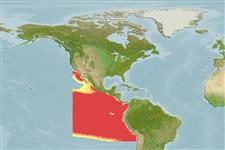Teleostei (teleosts) >
Aulopiformes (Grinners) >
Scopelarchidae (Pearleyes)
Etymology: Rosenblattichthys: Because of Richard Rosenblatt, ichthyologist os Scripp Institution of Oceanography in La Jolla.
Eponymy: Dr Richard Heinrich ‘Dick’ Rosenblatt (1930–2014) was an American ichthyologist and oceanographer. [...] (Ref. 128868), visit book page.
Environment: milieu / climate zone / depth range / distribution range
Ecology
Marine; bathypelagic. Deep-water; 33°N -
Eastern Pacific: California Current region from southern California to central Baja California Sur and equatorial eastern shores from about 6°N to 3°S (Ref. 35929); also Chile (Ref. 9068).
Size / Weight / Age
Maturity: Lm ? range ? - ? cm
Max length : 6.1 cm NG male/unsexed; (Ref. 46892)
Short description
Identification keys | Morphology | Morphometrics
A mesopelagic species (Ref. 35929). Oviparous, with planktonic larvae (Ref. 35929).
Life cycle and mating behavior
Maturity | Reproduction | Spawning | Eggs | Fecundity | Larvae
Pequeño, G., 1989. Peces de Chile. Lista sistematica revisada y comentada. Rev. Biol. Mar., Valparaiso 24(2):1-132. (Ref. 9068)
IUCN Red List Status (Ref. 130435: Version 2024-2)
Threat to humans
Harmless
Human uses
Tools
Special reports
Download XML
Internet sources
Estimates based on models
Preferred temperature (Ref.
123201): 2.2 - 3.2, mean 2.5 °C (based on 142 cells).
Phylogenetic diversity index (Ref.
82804): PD
50 = 0.5625 [Uniqueness, from 0.5 = low to 2.0 = high].
Bayesian length-weight: a=0.01122 (0.00514 - 0.02450), b=3.04 (2.87 - 3.21), in cm total length, based on all LWR estimates for this body shape (Ref.
93245).
Trophic level (Ref.
69278): 4.0 ±0.7 se; based on size and trophs of closest relatives
Fishing Vulnerability (Ref.
59153): Low vulnerability (10 of 100).
